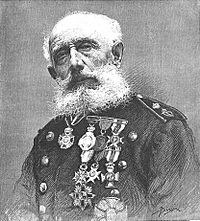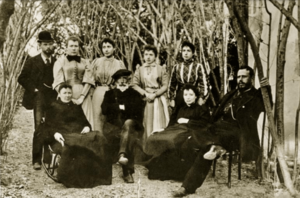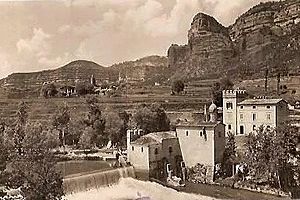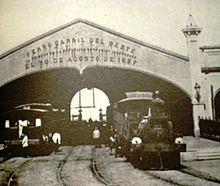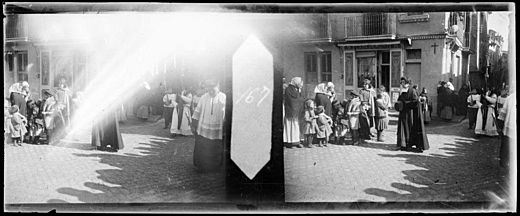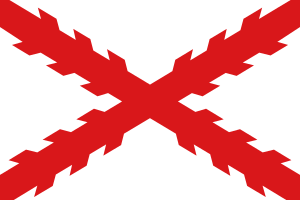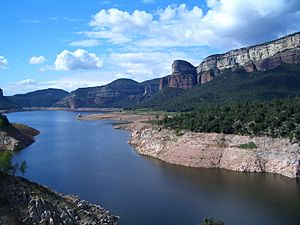Teodoro de Mas y Nadal facts for kids
Quick facts for kids
Teodoro de Mas y Nadal
|
|
|---|---|
|
|
|
| Born |
Teodoro de Mas y Nadal
1858 Barcelona, Spain
|
| Died | 1936 Vilanova de Sau, Spain
|
| Nationality | Spanish |
| Occupation | entrepreneur, landowner |
| Known for | engineer, politician |
| Political party | Carlism |
Teodoro de Mas y Nadal (1858–1936) was a Spanish engineer and politician. He helped build important things like railways, roads, and power plants. Most of his work was in Catalonia, Spain. He also worked in other parts of Spain and in Argentina. In politics, he supported a group called the Carlists. They believed in traditional ways and a specific royal family.
Contents
Teodoro's Family and Early Life
Teodoro's family, the Mas family, were landowners from a region called Osona. His great-grandmother was Joaquina de Vedruna. She became a widow and later started a charity order in 1825. She was made a saint in 1959.
Teodoro's grandfather and father were also involved in politics. They supported the "legitimists" during the Carlist Wars. These wars were about who should be the king of Spain.
Teodoro's father, Luis de Mas y Poudevida, was an engineer. He studied in France and worked on water projects. He also ran a technical college and managed a railway line in Barcelona.
Teodoro was born in 1858. When he was 14, he tried to join the legitimists in the Third Carlist War. He was too young at first, but he eventually joined the Royal Corps of Engineers. His own father was in charge of this group! Teodoro fought in battles and was even awarded a medal. He was later sent to France but was held there until the war ended.
After the war, Teodoro and his father lived in exile for a few years. Teodoro studied engineering, probably in France. He returned to Spain around 1883. In 1884, he married Josefa Bach Puig. They had at least 7 children.
Teodoro's Work as an Engineer
Teodoro de Mas was a civil engineer. This means he designed and built things like roads, bridges, and buildings. He worked on many different types of projects:
- Railways: He helped build train lines.
- Roads: He worked on road construction.
- Water Projects: He designed systems for water, like dams and power plants.
- Power Generation: He built facilities to create electricity.
- Industrial Buildings: He also designed factories.
Most of his projects were in Catalonia. But he also worked in other parts of Spain and even in Argentina.
Water Projects
Teodoro was very interested in water projects. He worked on the Saltos del Duero project in the province of Salamanca. He also worked on a plan to bring water from the Monellots springs to the town of Vich.
One of his biggest plans was to pipe water from the Noguera Pallaresa river to Barcelona. This was a huge project, about 100 kilometers long!
In 1901, he got a license to use water from the Ter river. This led to his most successful project. He built a hydroelectric power plant on his own land, called Molí de Sau. This plant used the river's water to make electricity. It sent power to Vich, helping homes get electricity.
Transport and Other Projects
Teodoro also worked on railways from the 1880s to the 1900s. In the late 1880s, he helped build railway lines in Corrientes, Argentina. In the 1890s, he tried to build a narrow-gauge railway line to connect Vich to the main network. This project, called "Ferrocarril a la Selva," didn't end up happening.
He also helped build roads in the province of Albacete in the mid-1880s. Finally, he designed and built a ceramics factory called La Fé in Buenos Aires.
Teodoro's Political Life
After his time as a young soldier, Teodoro de Mas was not very active in politics for many years. He joined a local Carlist club in Vich in 1889. He mostly made donations to the Carlist cause. For example, he helped pay for a monument to a Carlist hero.
In 1899, he ran for a local government position in Vich. Even though his family was well-known, he did not win. For a long time, he wasn't a major figure in the Carlist party.
Becoming a Regional Leader
Teodoro became more active in politics in the mid-1910s. He started attending local meetings and writing for party newspapers. In 1916, he was chosen to lead the Carlist party in the Vich area.
In 1917, he joined the main Carlist committee for Catalonia. He was put in charge of coordinating all Carlist election efforts in Catalonia. That same year, he ran for a position in the Barcelona Provincial Council. He ran as a Carlist, but he did not win.
Before the 1918 national election, Teodoro signed an important document called a "Manifiesto." This document explained the Carlist ideas. It talked about having a king from the Borbón family and protecting Spain's economy. These efforts led to two Carlist members being elected to the national parliament from Catalonia.
From Mellista to Carlist Again
Around 1919, there was a disagreement within the Carlist party. A key leader, Vázquez de Mella, left the party. Teodoro de Mas joined him and his new group, the Partido Católico Tradicionalista (Traditionalist Catholic Party). Teodoro said that "principles were more important than the king." He became the leader of this new group in Catalonia.
He worked to build up this new party and get public support. He led rallies and welcomed Vázquez de Mella to Catalonia. However, the new party struggled to grow.
When the Primo de Rivera government took power in 1923, Teodoro supported it at first. He hoped the new government would fix problems and follow traditional ideas. But by 1925, he started to disagree with the government's policies, especially those that he felt were against Catalonia.
When the Second Republic was declared in 1931, Teodoro was an older man. But after the death of the Carlist leader, he returned to the main Carlist party. He didn't take a leadership role, but he was seen as an important older figure. He sometimes appeared at rallies and donated money to the cause.
When the Civil War started in 1936, Teodoro went to his property near Vilanova de Sau. However, he was found by a group from Vich. Teodoro de Mas and his son-in-law were killed at his home.
See also
 In Spanish: Teodoro de Mas y Nadal para niños
In Spanish: Teodoro de Mas y Nadal para niños



